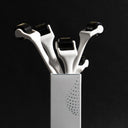When it comes to treating hair loss, choosing between PRP and finasteride can be challenging.
In this article, we'll explore the key differences between PRP vs finasteride, helping you understand which option might be best for your hair restoration journey.
Whether you’re seeking a treatment with fewer side effects or looking for the most effective results, this comparison will guide you in making an informed decision.
Table of content
What is PRP?

Platelet-Rich Plasma (PRP) is a treatment that uses a person's own blood, processed to concentrate platelets and growth factors, to promote healing and regeneration in various areas of the body, including stimulating hair growth.
How does PRP work?
PRP therapy is particularly popular in the treatment of hair loss. During the procedure, a small sample of the patient's blood is drawn and then spun in a centrifuge to separate the plasma rich in platelets.
This concentrated plasma is then injected into the scalp or other target areas where it releases growth factors.
These growth factors stimulate the hair follicles, encouraging new hair growth and improving the health of existing hair.
Side effects of PRP
Platelet-Rich Plasma (PRP) therapy, while generally considered safe, does have potential side effects, mostly related to the injection process itself. These are usually temporary and subside on their own.
Possible side effects of PRP therapy include:
- Mild pain or discomfort at the injection site.
- Infection, although this is rare due to the sterile techniques used.
- Temporary swelling or bruising at the injection site.
- Allergic reactions, which are very rare since the treatment uses the patient's own blood.
- Skin discoloration at the injection site.
- In rare cases, nerve damage or tissue damage may occur.
As your leading source for hair health information over the past 4 years, we never compromise on accuracy. When it comes to your health, you deserve information you can truly rely on - and earning your trust is our top priority.
Here's how Scandinavian Biolabs ensures every piece of content meets the highest standards of accuracy and integrity:
- Credentialed Experts: Our reviewers are actively practicing doctors and medical researchers
- Stringent Reviews: Content undergoes rigorous editing by subject specialists and review by a practicing doctor.
- Evidence-Based: We rely on well-established research from trusted scientific sources like peer-reviewed journals and health authorities.
- Full Transparency: Our editorial standards, writer credentials, reviewer credentials, correction process, and funding are all publicly documented.
- Independent Voice: While we do promote products, we operate in a vacuum to business operations. Our main goal is just an unwavering commitment to providing medically-sound guidance.
You can count on Scandinavian Biolabs to consistently deliver the trustworthy health information you deserve. Read our Editorial Standards.
What is finasteride?

Finasteride is a prescription medication commonly used to treat male pattern baldness by inhibiting the conversion of testosterone to dihydrotestosterone (DHT), thereby slowing or preventing hair loss.
Finasteride belongs to a class of medications known as 5-alpha-reductase inhibitors.
By blocking the conversion of testosterone to DHT, a hormone linked to hair thinning, it helps maintain existing hair and may even promote some regrowth.
It's usually taken in pill form, typically at a dosage of 1 mg per day for hair loss treatment.
How does finasteride work?
Finasteride works by inhibiting the action of an enzyme called 5-alpha-reductase. This enzyme is responsible for converting testosterone, the primary male sex hormone, into dihydrotestosterone (DHT). DHT plays a significant role in male pattern baldness by binding to hair follicles and causing them to shrink, ultimately leading to hair thinning and loss.
By blocking the conversion of testosterone to DHT, Finasteride reduces the levels of DHT in the scalp.
This allows the hair follicles to return to a more normal size and function, slowing down the hair loss process or even promoting some hair regrowth.
The treatment is generally effective in maintaining existing hair and can lead to visible improvements, particularly when started early in the hair loss process.
Side effects of finasteride
Finasteride, while effective in treating male pattern baldness, may lead to certain side effects. These can vary in severity and occurrence among individuals, and most are reversible upon discontinuation of the medication.
Possible side effects of Finasteride include:
- Sexual dysfunction, such as reduced libido, erectile dysfunction, or ejaculation disorder.
- Breast tenderness or enlargement.
- Depression or mood changes.
- Allergic reactions, such as skin rash or swelling of lips, tongue, or face.
- Testicular pain.
- In rare cases, an increase in breast cancer risk has been noted, though the link is not firmly established.
An effective alternative to PRP and finasteride

For those seeking alternatives to PRP therapy or Finasteride for hair loss treatment, Bio-Pilixin Serum by Scandinavian Biolabs presents an intriguing option.
This serum includes a combination of ingredients that are supported by scientific studies for their role in hair care.
Key Ingredients:
- Capilia Longa: A nutrient-rich medium from Curcuma longa stem cells, has been studied clinically and observations suggest it may reduce hair loss by up to 89–90% and improve hair density by 52%.
- Niacinamide: By enhancing blood circulation and shielding hair follicles from environmental stress, Niacinamide adds to the serum's effectiveness.
- Vanillyl Butyl Ether: This ingredient encourages localized blood flow within the scalp, ensuring efficient nutrient and oxygen delivery to hair follicles, vital for healthy growth.
Scandinavian Biolabs displays confidence in their product by offering an unparalleled 150-day money-back guarantee.
This assurance provides an added layer of trust for those willing to explore this path to improved hair health.
The ingredients in Bio-Pilixin Serum are chosen based on scientific research and offer another option alongside traditional treatments like PRP and Finasteride.
Supported by scientific studies and with a 150-day money-back guarantee, Bio-Pilixin Serum presents an option for men exploring hair care solutions.
PRP vs finasteride: What are the differences?

Platelet-Rich Plasma (PRP) therapy and Finasteride are two different approaches to treating hair loss, each with its unique mechanisms and considerations. PRP leverages the body's natural growth factors, while Finasteride is a prescription medication that targets specific hormones.
Understanding the differences between these two treatments can help individuals make an informed decision based on their specific needs and preferences.
Method of action
PRP involves injecting concentrated platelets from the patient's own blood to stimulate hair growth, whereas Finasteride works by inhibiting the enzyme responsible for converting testosterone to DHT, thereby preventing hair loss.
Treatment form
PRP is an injectable therapy administered directly to the affected area, often requiring multiple sessions. Finasteride is taken orally, typically as a daily pill.
Side effects
PRP's side effects are mostly related to the injection process and are generally mild, such as pain or swelling at the injection site.
Finasteride's side effects can include sexual dysfunction, mood changes, and other systemic reactions.
Long-term commitment
PRP may require ongoing sessions for continued benefits, while Finasteride requires continuous daily use to maintain its effects on hair growth.
Suitability
PRP can be suitable for both men and women, depending on the underlying cause of hair loss. Finasteride is primarily prescribed for adult men with male pattern baldness.
Cost
PRP treatments can be more costly, especially when multiple sessions are needed. Finasteride, being a prescription medication, might be covered by insurance or available as a generic, potentially making it a more affordable option.
PRP vs finasteride: Which one is better for you?
While both PRP and finasteride effectively treat hair loss, research suggests PRP may be a better option. It delivers strong results with fewer side effects, making it a safer and more appealing choice for many.
Ultimately, the best treatment depends on your specific needs and circumstances. It's always wise to consult with a doctor to determine whether PRP or finasteride is the right choice for you.
A professional can help you weigh the benefits and potential risks to find the most effective solution for your hair loss.
Conclusion
Hair loss is a complex issue that demands a tailored approach to treatment.
Whether it's the innovative PRP therapy harnessing the body's growth factors or the hormone-targeting prescription medication Finasteride, each option has unique benefits and potential drawbacks.
Understanding these can help individuals make the most informed and suitable choice for their hair loss situation.
For those exploring alternatives to PRP and Finasteride, Bio-Pilixin Serum by Scandinavian Biolabs offers a compelling, scientifically-backed solution.
With key ingredients like Capilia Longa, Niacinamide, and Vanillyl Butyl Ether, and the reassurance of a 150-day money-back guarantee, this serum presents another avenue in the journey toward restored hair health.
FAQs
Can women use Finasteride for hair loss treatment?
Finasteride is primarily prescribed for men with male pattern baldness. Its use in women is not commonly recommended, and pregnant women should avoid handling the medication, as it can potentially lead to birth defects.
How long does it take to see results with PRP therapy?
Results with PRP therapy may vary among individuals, but improvements are typically noticed within a few months of treatment. Multiple sessions may be needed to achieve the desired results, and ongoing maintenance treatments might be recommended.
Are there any long-term commitments required for Finasteride or PRP?
Finasteride requires continuous daily use to maintain its effects on hair growth, while PRP may require ongoing sessions for continued benefits. Stopping either treatment might lead to a reversal of the positive effects achieved.
Can PRP therapy be combined with other hair loss treatments?
Yes, PRP therapy can be used in conjunction with other treatments such as Finasteride or Minoxidil. Some studies have shown that combining PRP with conventional treatments may lead to significantly better results. Consulting with a healthcare provider specializing in hair loss can help determine the best combination for individual needs.
References:
- https://www.ncbi.nlm.nih.gov/pmc/articles/PMC4338465/
- https://pubmed.ncbi.nlm.nih.gov/9777765/
- https://pubmed.ncbi.nlm.nih.gov/9951956/






